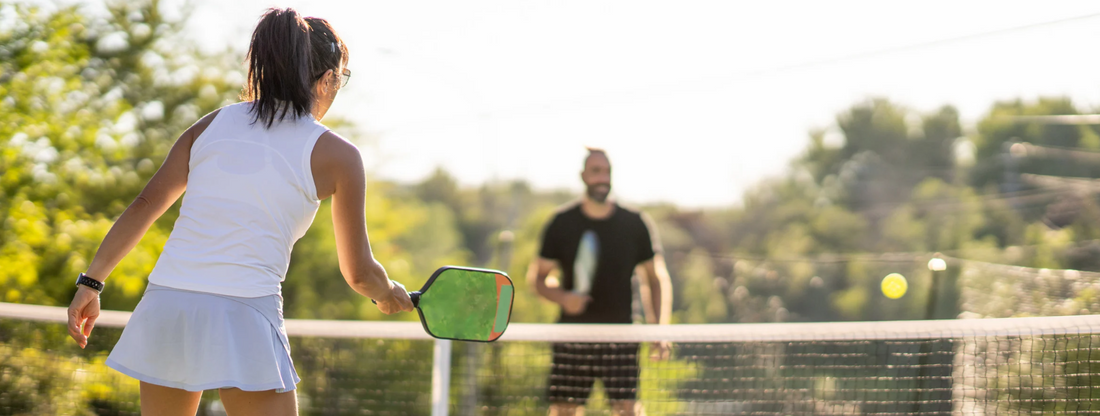
Singles vs. Doubles: How to Train Differently for Each Game Format
Share
While the paddle and the court may look the same, singles and doubles pickleball are two distinctly different beasts. One demands relentless coverage, raw endurance, and tactical one-on-one dominance. The other rewards synergy, court awareness, and seamless communication. To excel in either, you need more than just athletic ability, you need a tailored training regimen that reflects the unique tempo, tactics, and demands of each format.
This article unpacks the fundamental contrasts between singles and doubles play and outlines how to train specifically for each, from footwork to fitness to game IQ. Whether you're chasing solo glory or gunning for chemistry with a partner, sharpening your approach begins with understanding the training differences that set the formats apart.
Court Coverage: One vs. Shared Real Estate
Singles:
You are the sole guardian of 880 square feet. Every shot is your responsibility. That means more lateral sprinting, deeper court positioning, and a focus on stamina-based agility.
Training Focus:
- Side-to-side and diagonal movement drills
- Drop shot retrieval and backcourt recovery
- Full-court shadow swings to practice shot selection under fatigue
Doubles:
Court space is split, but responsibilities multiply. Doubles demands precise positioning, trust in your partner, and quick reflexes in the non-volley zone.
Training Focus:
- Coordinated footwork and split-step timing
- Compact, quick-reaction drills at the kitchen line
- Transition zone coverage and team communication exercises
Shot Selection and Strategy
Pickleball Singles Strategy:
In singles, patience meets pressure. Long baseline rallies, angled passes, and punishing drop shots form the cornerstone of tactical success.
Key Shots to Practice:
- Deep serves and returns to control center court
- Inside-out forehands for corner exploitation
- Third-shot drops that neutralize power and pull opponents forward
Mental Emphasis:
Control the tempo. Force your opponent to move. Minimize unforced errors by recognizing when to attack and when to defend. Each shot must have intent.
Doubles Play Dynamics:
In doubles, it's all about collaboration and disruption. The net is your battlefield, and the kitchen is your command center. Short exchanges, strategic dinks, and planned poaches define the play.
Doubles Pickleball Drills to Prioritize:
- Cross-court dink rallies to build soft touch and patience
- Poach-and-cover drills to master switching and communication
- “Firefight” hand-speed battles for reflex improvement
Mental Emphasis:
Read your partner. Coordinate movement. Choose high-percentage plays that maintain pressure without overcommitting. Trust and rhythm win points.
Physical Conditioning: Endurance vs. Explosiveness
Singles Training Requirements:
Endurance reigns supreme. You need sustained foot speed and cardiovascular resilience to track down every shot and recover quickly.
Sample Workouts:
- Interval sprints with lateral cuts
- Jump rope sessions for foot rhythm
- Resistance training focused on unilateral movement and core balance
Doubles Training Requirements:
While not as physically taxing overall, doubles requires bursts of acceleration and core-to-extremity coordination. It's about quickness, not mileage.
Sample Workouts:
- Reaction ladder drills
- Medicine ball throws for rotational strength
- Plyometric bursts like lateral bounds or box jumps
In doubles, your first step matters more than your fifth. Train accordingly.
Communication and Anticipation
Singles:
Anticipation is internal. You read your opponent’s body language, spin tendencies, and court patterns to make split-second decisions.
How to Improve:
- Study match footage of top players
- Work with coaches to break down shot sequences
- Play solo games that encourage reading and adapting to unfamiliar tactics
Doubles:
Anticipation is shared. You must predict not only your opponents’ intentions but also your partner’s decisions.
How to Improve:
- Practice drills that include verbal shot calling
- Engage in switching drills to master territory coverage
- Use mirrored drills to practice coordinated motion
Trust is built through reps. Communication is polished through repetition and real-time feedback.
Equipment Considerations
Yes, even your paddle preferences may shift between formats.
For Singles:
- Slightly heavier paddles for deeper drives and extra power
- Larger sweet spots to reduce error margin on full-court swings
For Doubles:
- Lighter paddles for quicker reaction time at the net
- Paddles with textured surfaces for better spin during dinks and resets
Dialing in your gear to match your game can give you the subtle edge you didn’t know you needed.
Final Thoughts: Train With Intent, Play With Precision
Mastering both singles and doubles requires a versatile skill set, but the paths to mastery are different. One tests your solo grit, the other your collaborative finesse. By tailoring your training differences to the unique demands of each format, you elevate not just your performance, but your enjoyment of the game itself.
So the next time you lace up your court shoes, ask yourself: Am I training for the player I need to be in singles or doubles? The answer could be the difference between playing well and playing brilliantly.












